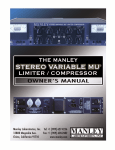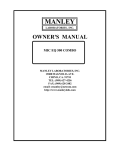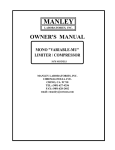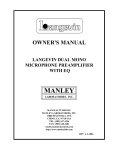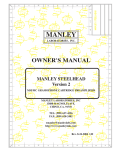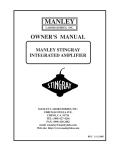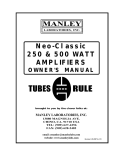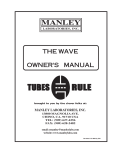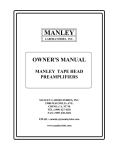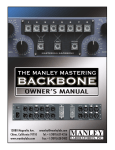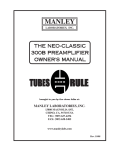Download Manley TUBES RULE 300B Owner`s manual
Transcript
MANLEY LABORATORIES, INC. MANLEY STEREO VARIABLE MU® LIMITER COMPRESSOR OWNER'S MANUAL TUBES RULE brought to you by the clever folks at: MANLEY LABORATORIES, INC. 13880 MAGNOLIA AVE. CHINO, CA. 91710 USA TEL: (909) 627-4256 FAX: (909) 628-2482 email: [email protected] website: www.manleylabs.com Rev 2-26-2004 CONTENTS SECTION PAGE INTRODUCTION 3 MAINS CONNECTIONS 4 INSTALLATION 5 FRONT PANEL 6 REAR PANEL 7 EXAMPLE SETTINGS 8 FRONT PANEL ADJUSTMENTS 9 OPERATIONAL NOTES 10 TECHNICAL NOTES 11 MASTERING AND M/S MODELS 12 GAIN REDUCTION CURVES 13 SPECIFICATIONS 14 SERVICE ADJUSTMENTS 15 WARRANTY 16 WARRANTY REGISTRATION 17 BLANK TEMPLATE TO STORE SETTINGS 18 INTRODUCTION THANK YOU!... for choosing the Manley Laboratories Stereo Variable Mu® Limiter Compressor. this unit has been our best selling product for many years. It is one of the very few compressors that has become a real standard in Mastering studios and contributed to most hit records over the last decade and probably the next. "Mu" is tube-speak for gain, and Variable Mu® is our registered trademark for this limiter compressor. It works by using the "remote cut-off" or re-biasing of a vacuum tube to achieve compression. The precious vintage Fairchild 670 also uses this technique and is one of few all-tube compressor to do so, that we know of. Even the side-chain has glowing rectifier bottles. How’s it work? The unique 5670 dual triode is at the center of the peak-reducing and compression action constantly being re-biased by the vacuum tube rectified side-chain control voltages which cause this tube to smoothly change its gain. Just like that. LOCATION & VENTILATION The Manley Stereo Variable Mu® Limiter Compressor must be installed in a stable location with ample ventilation. It is recommended, if this unit is rack mounted, that you allow enough clearance on the top and bottom of the unit such that constant movement of air can flow through the ventilation holes. There are 8 tubes inside this unit so it does run quite hot. Good ventilation is definitely encouraged. UNPACKING: Unpack the unit carefully by removing all the custom foam packing material and make sure that all supplied accessories are present. Carefully examine all items for any possibility of shipping damage. All of the tubes are already installed and should have survived the journey from our factory to your studio. They should be standing at attention in their sockets, and should show no signs of distress such as chipped glass, loose internal components or obvious breakage. If the unit is damaged or fails to operate, notify the shipper or your dealer or us or your local authorities immediately. Or if you suspect The Shipping People threw it off the airplane and onto your front porch whilst flying overhead at 30,000 feet, notify the shipping company without delay and complain to them as we only guarantee this unit to be able to survive a drop of 23,487 feet or less. Your Manley Variable Mu® Limiter Compressor was packed by Manny Q. with extreme love and each box includes the following components and accessories: a) 1 each, 6 foot IEC 3-conductor power cable b) 1 each, Owner’s Manual (that we hope you will keep reading.) It is prudent to retain the shipping materials for future use, as they are custom-formed for this unit and will greatly minimize the chance of shipping-related damage should you ever need to put your precious Variable Mu® in the careless hands of The Shipping People again. We have heard that certain rodents might enjoy munching on the packing foam. We are sorry to report that we do not warranty the packing foam against attack by mice, rats, or other hungry critters, hungry children, hungry neighbors, etc. Try glue traps or spring-traps loaded with peanut butter to eliminate these unwelcome freeloaders from your property. 3 MAINS CONNECTIONS Your Manley Stereo Variable Mu® Limiter Compressor has been factory set to the correct mains voltage for your country. (Well, that is what we intended to do when we knew where it would be initially shipped.) The mains voltage that we set this unit for is marked on the serial badge, located on the rear of the chassis. There is also a brightly coloured sticker indicating the mains voltage setting next to the IEC mains entry socket. Check that this complies with what comes out of your wall. If it is not... ...there is a voltage changeover switch inside the unit! The power transformer's primaries can be switched between parallel for 120v operation or in series for 230v or 240v countries so be sure to check the sticker and the serial number voltage indication for proper mains voltage. Failure to properly comply with mains voltage requirements can cause extensive damage to the unit, which of course would not be covered by the warranty. If you relocate from, say, a 120v country to a 240v country, you will need to change the voltage changeover switch. This is achieved by first disconnecting the IEC mains cord from the rear of the unit (!) Remove the top cover by unscrewing the two silver 4-40 phillips head screws on the top cover and sliding the cover out towards the rear of the unit. Locate the round black voltage changeover switch on the power transformer board. Use a small flat screwdriver to swiftly rotate the inner section of the voltage changeover switch to the desired position, labelled 110v or 220v. It is a good idea to put some brightly coloured stickers on the unit like we did to remind yourself that you have changed the voltage. If you change your mains voltage, you will also need to change the MAINS FUSE. The MAINS FUSE may be checked by first disconnecting the IEC mains cord from the power supply’s power inlet plug. Then gently push and rotate counter-clockwise the black fuseholder cap located next to the IEC power socket. The fuse and cap should spring outward toward your fingers. The fuse is a glass or white ceramic thing with silver end-caps. Inspect the mains fuse for the proper rating; change if necessary. Refer to the fuse rating chart in the specifications section of this manual. If you do not know what a blown fuse looks like, you may measure for continuity across the fuse ends. If your meter reads “OL” when you measure across the fuse, that means “Open Leads” and that would mean the fuse is blown. A blown fuse usually indicates A Very Bad Thing occurred. If this has happened to you, try to figure out why it may have happened. (Using a Fast Blow fuse when we have specified a SLO-BLO fuse is one reason.) If you have no idea why a fuse might have just blown on its own, you might want to consult with Manley Labs or your dealer for further advice as Something Very Bad might have occured, like the power transformer might have decided to retire early. One way this could happen is by running the wrong mains voltage into the unit. Be sure not to do that. If you live in a strange place... Export units for certain markets have a moulded mains plug fitted to comply with local requirements. If your unit does not have a plug fitted the coloured wires should be connected to the appropriate plug terminals in accordance with the following code. GREEN/YELLOW BLUE BROWN EARTH terminal NEUTRAL terminal LIVE terminal As the colours of the wires in the mains lead may not correspond with the coloured marking identifying the terminals in your plug proceed as follows; The wire which is coloured GREEN/YELLOW must be connected to the terminal in the plug which is marked by the letter E or by the safety earth symbol or coloured GREEN or GREEN and YELLOW. The wire which is coloured BLUE must be connected to the terminal in the plug which is marked by the letter N or coloured BLACK. The wire which is coloured BROWN must be connected to the terminal in the plug which is marked by the letter L or coloured RED. DO NOT CONNECT OR SWITCH ON THE MAINS SUPPLY UNTIL ALL OTHER CONNECTIONS HAVE BEEN MADE. (...or else...) 4 INSTALLATION Please refer to the REAR PANEL section for a full layout of the rear panel of your Manley Stereo Variable Mu® Limiter Compressor. 1. Make sure your mains voltage supply agrees with the voltage this unit is set for as described on the previous page. 2. Be certain that the unit has the proper fuse installed. 3. Connect the input signal(s) to the 3 pin female XLR's on the rear panel. The input XLR's are TRANSFORMER COUPLED balanced wired as follows: PIN 1: GROUND PIN 2: (+) POSITIVE GOING PHASE PIN 3: ( - ) NEGATIVE GOING PHASE 4. Connect a 3 pin XLR cable to the male output XLR on the rear panel. The output XLR is balanced and the pinout is wired as follows: PIN 1: GROUND PIN 2: (+) POSITIVE GOING PHASE PIN 3: ( - ) NEGATIVE GOING PHASE The output impedance is 600 Ohms nominal. 5. Connect a standard IEC mains cable to the IEC mains socket on the rear panel. 6. Check that the power is switched off on the unit. 7. Connect the IEC mains cable to a 50/60 Hz AC source of the proper selected voltage. 8. Power up the unit and allow it enough time to stabilize before using . it takes about 30 minutes for everything to stabilize and for it to warm up and sound its best. Again, let us remind you: this unit runs pretty hot. We definitely encourage allowing enough space around the chassis so that convection of air can occur and heat can be drawn away from the unit. If the heat gets all trapped with no place to go, you'll just bake up the guts of the unit faster and you'll be in for a re-cap years sooner than if you had some ventilation happening. Try to give the Variable Mu® at least an inch or two on top so that air can flow up and away from it. If you wish to keep pizzas warm on top of the Manley Variable Mu®, please use a plate so the cheese does not drip down through the top cover holes into the unit. Your Warranty does not cover damage arising from foreign (or domestic) dairy substances entering the unit. 5 FRONT 8 12 10 6 PANEL MANLEY STEREO VARIABLE MU® LIMITER COMPRESSOR 4 2 RECOVERY 0 MANLEY OUTPUT DUAL INPUT OUTPUT FAST SLOW 12 10 8 6 4 2 RECOVERY FAST 0 MANLEY SLOW LABORATORIES INC. LABORATORIES INC. REDUCTION dB REDUCTION dB THRESHOLD ATTACK ATTACK IN THRESHOLD LIMIT LIMIT SEP LINK COMPRESS COMPRESS MIN MAX SLOW FAST FAST SLOW MAX IN MIN POWER BYPASS A BALANCE ADJUST H METER B METER CD EF GHI EF CD B ADJUST BALANCE H BYPASS A A IN / BYPASS Switched in bypass mode, (down position) all effects of the limiting circuitry are bypassed and will not affect the audio signal. In the bypass mode , the audio signal passes from the input directly to the output. B. COMP. / LIMIT Selects compression ( 1.5:1) or limiting (4:1) function. Compression is soft -knee, Limit is a sharper knee. At greater than 12dB of limiting the ratio increases (up to 20:1 maximum) C. RECOVERY Recovery times can be selected between a. VERY SLOW 8 seconds b. SLOW 4 seconds c. MEDIUM .6 seconds d. FAST .4 second e. VERY FAST .2 second D. THRESHOLD Continuously variable gain reduction threshold control. Determines the necessary amplitude for compression or limiting to take effect. Most extreme effect is at the MIN (fully counter clockwise) position. The lower the threshold, the more that gets limited. E. OUTPUT ATTENUATE Continuously variable attenuation of output signal leaving the amplifier circuitry. Full attenuation occurs at the full counterclockwise position. This control is active only in IN mode. F. ATTACK Continuously variable sensitivity of transient detection. Determines the necessary length of transient to initiate gain reduction. Fast =25mS, Med =50mS, Slow =70mS. Fully counter clockwise at the slowest setting will prevent most percussive signals from causing limiting or compression. G. DUAL INPUT Continuously variable attenuation of input signal entering the amplifier limiting circuitry Full attenuation occurs at the fully counterclockwise position. This control is active only in IN mode. I. LINK When switched to "SEP" left side is independent from the right side. When switched to "LINK" both channels are reduced in gain by the same number of dB. This insures that the stereo image is unchanged. The METERs remain independent to help set THRESHOLDs. I. POWER ON/OFF Power is supplied to the unit when switched UP. Meters will illuminate H. GR METER Measures in decibels amount of reduction 6 REAR PANEL FUSE 2A SLOBLO CIRCUIT GROUNDS CHASSIS CHANNEL B INPUT CHANNEL B OUTPUT CHANNEL A INPUT CHANNEL A OUTPUT IEC POWER CONNECTOR DE AB C DE A FUSE HOLDER Houses a standard 2 Amp SLO-BLO fuse. Replace only with the same type and size. B IEC MAINS SOCKET Standard 3 pin AC mains socket. See the section MAINS CONNECTIONS for more details. C GROUND TERMINALS Use these terminals to help with hum problems. Normally the two terminals are connected together. D OUTPUT XLR 3 Pin XLR BALANCED. Pin 1 - Ground Pin 2 - Positive going phase (+) Pin 3 - Negative going phase (-) E INPUT XLR 3 Pin XLR BALANCED. Pin 1 - Ground Pin 2 - Positive going phase (+) Pin 3 - Negative going phase (-) POWER TRANSFORMER FUSEHOLDER IEC RECEPTACLE 12 VDC REGULATOR 12 VDC REGULATOR METER METER TUBES and TRIMS OUTPUT TRANSFORMER OUTPUT TRANSFORMER REG REG 7044 7044 12AL5 12AL5 BALANCE BALANCE CH1 INPUT TRANSFORMER CH2 INPUT TRANSFORMER 5670 5751 5670 COMPRESS ZERO TRIM 5751 COMPRESS ZERO TRIM 7 this page for example settings FRONT PANEL ADJUSTMENTS Initial basic settings for line level use: 1 -Begin with POWER ON, BYPASS, SEP and COMPRESS 2 -Set all controls at 12:00 ( or THRESHOLD at min) (for calibration feed in a 1Khz oscillator at 0 VU and confirm the return from the unit is actually 0 VU. Switch from BYPASS to IN and adjust the individual OUTPUTs to also return 0 VU.) 3 -Switch from BYPASS to IN and adjust the DUAL INPUT to get 3 to 6 dB of gain reduction on the meter with either COMPRESS or LIMIT. Fine adjust with the Thresholds. 4 -Adjust the individual OUTPUTS to either have a comparable level with BYPASS or provide the desired level to tape. Use the recorder's meters. Digital recorders use Peak Meters and Analog usually uses VU meters. Machines may use different calibrations. If the source is "stereo" then the best method is to switch from SEP to LINK. This insures that both left and right sides will change gain the same amount at the same time. That way a sound located in center will stay in center and not move around. This unit uses both the channels to control the gain. That means that similar settings should be set up on both sides. You should not just depend on adjusting one side. The usual mistake is forgetting about the LIMIT / COMPRESS switch, so check that they match first. Use both meters. Some compressors mix left and right then use that mono signal to control compression with the left side controls. This makes it easy for some to adjust but its not right. We combine the "DC" control signals not the audio. Because Compress has lower "ratios" than Limit the Threshold will seem to have less range. Actually the range is the same - only the result is less gain reduction. Turn up the Input. If the source is too percussive or has loud drums in the mix: try adjusting the ATTACK and RECOVERY controls. Sometimes fast Attack and medium Recovery helps tame drums. Conversely if the drums are "sitting pretty" then slow the attack. Fast ATTACK & RECOVERY settings tend to reduce transients. Slower ATTACK preserves the mix and drums should not trigger compression - overall level will. Only the fastest settings are the only way to make this unit pump like a cheap old solid state limiter. Even then you have to do some drastic Limiting. We designed the Variable-MU to be difficult to dial in a "bad" setting. The control range is wide but not extreme - not zero to infinity. Music before spec sheets. Slower RECOVERY settings tend to be the most inaudible. The more bouncy the meter seems - the more likely that limiting is audible and may be regrettable. Pumping is no longer in "fashion" now, we hear. If you want a fast analog "brick-wall" limiter that doesn't mess up the music - dream on - they don't exist. The Variable-MU will probably do what you actually need. The trick is to use slow Recovery and less than 5 dB of Limit which often translates to "lower the input". In this unit the "knee" softens as more limiting is used. This tends to act like a compressor followed by a limiter. This is good but not perfect. Up to about 10 dB of gain reductionshould be mostly inaudible. This is why the original name of the unit was the 10 dB Limiter. However, watch out for quiet passages - they will get loud - a giveaway that somebody is seriously "overcompressing". Rather than heavily limiting the mix - Gently compress individual tracks during recording, gently compress the mix and save the final limiting to the mastering engineer who is probably also going to use a Variable-MU - followed by their state-of-the-art digital limiter. That way, only the radio stations and MTV will "over-compress". Did you know that the louder the CD, the more it is likely to push the station's limiters into the cringe zone. For broadcast, average loudness is often a better goal that the loudest possible CD. It all comes out the same in the end. Controlling dynamic range is important for pop. Watch out for big peaks in the extreme lows and highs - broadcasters use and abuse multi-band limiters. Your call... 9 OPERATION NOTES The "MANLEY STEREO VARIABLE MU LIMITER - COMPRESSOR" is designed for multiple purposes. The unit can be used stereo or as 2 individual channels of limiting or compression. It can be used as a balanced line amp capable of 24 db! of gain and as a pre-amp for low level signals. . With higher input gain settings the unit can be used to create gentle tube distortion if desired. Modest settings will often enhance the signal in ways difficult to describe however the range includes "tube warmth", richness and enhanced clarity and magic. We know several famous producers and engineers that record every possible track, and the mix and then master through these LIMITER-COMPRESSORS. The attack and recovery controls are important to understand. The response to transients and percussive sounds are affected by the attack control. Recovery is the time it takes for the gain to return to normal or zero reduction. This is called "RELEASE" on some limiters. We can use a typical mix with dynamic vocals, drums and bass for an example. With this example a fast attack setting will react to the drums and reduce the overall gain. If the recovery is very fast then the gain will return to normal quickly. This will have an audible effect of reducing some of the level and attack of the drums in the mix. As the recovery is set slower the gain changes that the drums cause might be heard as "pumping". Now these gain changes caused by the drums are pulling down vocals, some bass and causing volume changes. Slower recovery settings will usually keep the gain changes more inaudible but will also lower the perceived volume. A slow attack setting will tend to ignore drums and other fast signals but will react to the vocals and bass in our example. A slow attack might also let a hard kick drum transient distort the next piece of equipment in the chain. We have set up the unit so that medium settings of both controls provide good gain control and little change in mix values. LIMITING OR COMPRESSION Two basic rules of thumb with any compressor or limiter should be reminded. Typical amounts of gain reduction shown by GR meter should be 2 to 6 dB. The more that the needle swings the more likely the gain changes will be audible. Listen for objectionable "pumping" with fast settings. Use your ears to determine optimum settings more than the meters. Some limiters add unpleasant artifacts with any reasonable looking setting. This limiter may give some magic at unexpected settings. It may help to use the bypass switch to compare the original input with the processed output to verify that an improvement is real. Then, because the peaks are reduced, the final output can be adjusted a little louder that the input. It should be borne in mind that the intended usage, and function therefore, is very different between limiting and compression. In limiting mode we are seeking to control PEAK overshoots or the 'ceiling' level as inaudibly as possible, normally in the 2 to4 dB area. By using compression we seek to "fold in" a ratio of, say, 20 or more into 10 dB. Both limiting and compression can produce the effect of increasing the average levels and background noise - depending on the degree or amount of limiting / compression used. Because dynamic range and peaks can be reduced, often overall loudness can be increased at the output. This is called GAIN MAKE-UP on some compressors and is simply the OUTPUT ATTENUATOR with this unit. Limiters often are designed for very fast attack times only. This assumes that the unit will almost always be used to prevent electronic clipping or overload. Typically the release with these is slow to prevent audible damage to the mix. With this unit you can adjust the attack, release and even the overload point in musical ways. Distortion can be creatively used by turning up the INPUT and turning down the OUTPUTs while using very little or no COMPRESSION. The cleanest settings are easiest to set up and most recommended for mixes. Set the THRESHOLD near "MIN", set the ATTACK near "FAST" and adjust the INPUT for 2 to 4 dB of LIMITING, then adjust the OUTPUTS to reach the levels you want or by comparing with BYPASS. You can fine tune the ATTACK, RECOVERY and THRESHOLD to taste from this. Compression with this unit begins at the same threshold so to achieve similar amounts of gain reduction you may have to turn up the INPUT or turn the THRESHOLD to "MIN". We also suggest while in "LINK" that both channels are set up the same or similar. LINKing with one channel in LIMIT and the other in COMPRESS will not work. The gain control chain is technically called a feedback circuit. Most modern compressors use a feedfoward circuit which sounds unmusical to us but for features sake usually offers a Ratio control. Some engineers get great results from blending the output of the limiter with the "straight" signal. This trick obviously is easier to do on individual tracks and sounds like a very gentle compressor that lifts quiet sections. 10 TECHNICAL NOTES SWITCHING ON The power switch is located on the right hand corner of the front panel. Flip the switch up to turn on the Limiter Compressor and down to turn off . TUBE LIFE As with all tubes, their quality degrades with age. This is due to cathode emission, a natural process found in all tubes. We recommend that you have your unit checked every 4-5 years, depending on usage, usually the limiter will require re-tubing after this time has elapsed. Furthermore, any adjustments such as meter calibration should be performed when the unit has sufficiently 'warmed up'. NOTE Almost all compressors have only two "gain" controls of a possible three: Input, Threshold and Output. With all three theoretically one is redundant. Utilizing a Dual Input has confused some "engineers" when it was needed for two different sounds. Simply find a good compromise position on the Dual Input and use the Threshold and Output as usual. The Input control is very useful with stereo material - try it - but it is not meant to be used for stereo "fades". Use it to set up a general level and final tweaking. OPERATION The principle of operation of this unit is based around a 5670 variable-mu (variable gain) double triode operating in a fully balanced or symmetrical circuit. Because of the need to preserve symmetry, a balance-adjustment pre-set potentiometer is placed onthe vertical circuit board adjacent to the 5670 variable-mu double triode. This control is set so that the two individual triodes amplify equally. (See Adjustments Section). The benefits of utilizing a variable-mu vacuum tube as the 'heart' of the limiting (or compression) function is that a widely varying range of input signals can be handled in a rapid-acting without introducing harmonic distortion - unless the operator / engineer wishes to do so for creative reasons. As with all compressor limiters there will be little change of gain reduction with various settings of ATTACK and RELEASE controls using a sine wave source. With music there will be changes in the amount of gain reduction with changes of these controls. OPTIONS Also available: MASTERING VERSION-- with 1/2dB THRESHOLD, and OUTPUT CONTROLS, 5 POSITION INPUT PRESET SWITCH, 12 POSITION ATTACK CONTROL. All built up on Grayhill sealed gold contact switches for maximum sonic integrity, repeatability, and accuracy within immeasurable tolerances. The panel has each step marked for precise recall. Retail price is $5,000 USD. There is also an option to emulate the verticle/lateral switch found on Fairchild 670s. This provides for some M/S coding/decoding. We provide both input and output switches. Other possibilities include sidechain inserts, remote metering, etc. Avoid ordering all possible options there is only so much we can fit. EARLY VERSIONS Originally we used 6386's as the variable MU tube. These are now too rare. They will not directly replace the 5670 in your unit without component changes. The 7044 output tubes are an improvement on the original 12BH7 - Higher output current and better consistancy being the prime reasons. We also improved the transformers from the first units made. 11 NOTES ON MASTERING MODIFICATIONS The Mastering Version of the Variable MU Limiter Compressor uses expensive Greyhill rotary switches with gold contacts where conductive plastic pots were used. The steps are determined with a large number of 1% precision metal film 1/2 watt resistors. The best conductive plastic pots only have 10% or 20% tolerance. The ten fold improvement in precision helps a great deal in left-right matching. There is a subtle audible improvement with stepped switches as well. Audiophile HI-FI often uses that technique to wring the last drop of performance out of a pre-amplifier. And I bet you wanted stepped switches mostly for resets. The Dual Input is a five position switch with a generic optimum setting of "0" in the 12:00 position. Each step in either direction is 2 dB. For reference Unity Gain is "0". The Output Attenuators are in half dB steps. Reference Unity is -11.5 or fully counter-clockwise. You might think of these as "gain makeup". They are marked technically, in that "0" or fully clockwise has zero attenuation in the circuit. The tube circuit actually has 15.5 dB of gain. The Input attenuator at "0" removes 4 dB and the Output attenuator removes the last 11.5 producing "unity". With a little compression the "gain make-up" available with the Output Attenuator is very handy. The Threshold is in half dB steps calibrated to LIMIT mode. In Compress the steps are approximately 1/4 dB. There are 24 steps so LIMIT gets a 12 dB range and Compress has a 6 dB range of adjustment. In some cases it is common to use the Input Attenuator to find a good starting point. Some Mastering engineers find using the combination of Input, Output and Threshold to achieve a little different "drive". Another good reason for stepped gains. The Attack Time has been slightly extended in both directions compared to a regular Variable-MU and divided into 11 steps. The approximate values are: CW (fast)15mS, 20, 25, 30, 35, 40, 50, 60, 70, 80, 90mS (slow) CCW. The Recovery has always been a 5 position switch. The times are: 200mS, 400mS, 600mS, 4S, 8 Seconds. NOTES ON M/S MODIFICATIONS The M/S modification allows various approaches to Mid/Side recording, playback and processing. There are separate switches for both input and output. Normal STEREO operation is with both switches pushed towards the right. M/S mode is with the switches to the left. The left switch changes the way the transformer inputs are wired (instead of an "active circuit") to derive M/S. The right switch changes the output wiring. When both the Input and Output switches are in M/S, then if one feeds normal left and right signals - the output will also be left and right. The signal would be "encoded" then "decoded". This can be useful because the compressor can process mid and side differently. Now the "Channel One" Threshold, Attack and Recovery are for the mid, sum or mono part of the sound - "Channel Two" Threshold, Attack and Recovery are for the side or difference part of the sound. If the Link switch is SEP then adjustment of "width" is possible using the Threshold controls and some gain reduction. To "widen" simply compress more in Channel One. In LINK mode the adjustment of width is not possible but one can use more of the "Mid" (or "Side") to control overall Limiting. This is useful for material meant for stereo broadcast. FM splits the signal into M/S and transmits as M/S. Broadcast engineers are generally more concerned that the mono component is solid because it transmits much further - and that relates to audience size and perceived quality. To "decode" mics in the M/S configuration one can either switch the input or output to M/S. Generally the input would be switched to M/S and the compressor and all after it will now have left and right. To "encode" program for FM broadcast and bypass the transmitter encoder, either the input or output switches can be used. If the unit is to be used for compression then it is normal to follow the output with a very good Limiter. This approach sounds louder and less "processed" than multi-band processors. It also allows a finer degree of control to the critical mono signal. 12 this page is for G.R. Curves SPECIFICATIONS Electronics Input Impedance Transformer Input, 3 dual triodes in balanced symmetrical variable mu circuit / line amp and Transformer Output per channel. Vacuum tube audio rectification for side chain. Custom Meters, Attenuators, etc. Input and output transformers designed by David Manley and wound inhouse at Manley Lab's magnetics department. 600 ohms Balanced, PIN 2 HOT Output Impedance 600 ohms Balanced, PIN 2 HOT Gain 3O dB Minimum, 35 dB typical (line amplifier) Maximum Input +36 dB (52 V RMS) (estimated for 1% THD) Input attenuator is before input transformer GR Thresholds Onset of LIMIT -20 dBM to +10 dBM (input at 9:00) Onset of COMPRESS -10 dBM to +10 dBM " Maximum Output +30 dB (26 V RMS) (26 dB headroom) Output attenuator is T pad after Output Transformer Noise Floor -80 dB : 20Hz to 80Khz: -90 dB typical Distortion .1 % at unity gain 100 Hz to 3 Khz typical .2 %: 20Hz to 10Khz at typical settings Frequency Response +/- 1dB from 20 Hz to 20 Khz Recovery Time .2 sec , .4 sec, .6 sec , 4 sec , 8 sec Attack Time 25 ms (Fast) (50 mS at 12:00) to 70 ms (Slow) Applications Professional audio recording, mixing and mastering. Power Consumption Fuse type: 48 watts 2 Amp slo-blo (@ 120VAC),1 Amp slo-blo (@240VAC) Tubes: 2 X 5670 2X 12AL5 2 X 7044 / 5687 Direct replacement. 2 X 5751 / 12AX7 Direct replacement. 14 SERVICE ADJUSTMENTS These are factory presets. These should only be altered after a re-tube. A METER CAL - GR ACCURACY 1. Supply a line level input signal (1K TONE OK) 2. Adjust front controls for NO LIMITING 3. Back down the reduction control to achieve 6dB of actual limiting as observed on an external calibrated audio frequency test meter. 4. Adjust each channel's trimpot located on the extreme back edges on horizontal PCB to calibrate. B METER - Adjusts meter "ZERO". Needs to be well warmed up. 1. Set in Limit Mode. No Signal 2. Adjust front panel METER ADJUST so that meter reads ZERO gain reduction. C 3. COMPRESS TRIM - Also adjusts meter ZERO but in compress mode. 4. Locate the internal trimmers directly next to the meters. 5. Switch to COMPRESS and adjust trimmer for ZERO on the meter. The above adjustments interact - The order of adjustments needs to be followed. It is worth doing these steps again to fine tune the trims. D. To adjust internal balance and lowest distortion: NOTE: This unit has been factory set for the lowest THD and optimum AC balance. It is recommended that this control be reset only after changing 5670 tubes. 1. 2. 3. 4. E Adjusting this control adjusts the current draw of the 5670 cathodes. Set a multimeter to read DC volts. Connect a good DC voltmeter to the two test points below the GR meter. Adjust the small trim pot located on the front panel and marked "ADJUST" until the METER nulls to zero. 5. This procedure is best done by ear with loud drum tracks. Set Attack and Recovery for fastest settings and at least 6 dB of Limiting. Start the trimmer at center and while listening carefully to the output adjust the trim for minimum "thumping". We select 5670's to minimise this. Trim procedure "D" also affects "thumping". The best procedure involves all of these. We push the limit on the attack time for this circuit and symetry is critical. TROUBLESHOOTING NOTE: Occasionally we have had units sent to us to service that had no problem. The symptom was clipping only when the unit was in the processing chain. Remove the unit and distortion gone. However in the shop - no problem. The cause was a combination of the somewhat low input impedance of the Limiter/ Compressor and the somewhat "wimpy" line driver of the preceding device. The solution - change the order of processing so that a more professional device fed the Limiter / Compressor. The input impedance is over 1Kohm and most devices are supposed to drive 600 ohms (which is twice as hard) but in this era of ICs and semi-pro gear claiming to be pro well....... B D B D 6386 12AL5 6386 C C E TUBES 12BH7 12AL5 TUBES E 12AX7A 12AX7A 12BH7 A A METER CAL METER CAL 15 WARRANTY All Manley Laboratories equipment is covered by a limited warranty against defects in materials and workmanship for a period of 90 days from date of purchase to the original purchaser only. A further optional limited 5 year transferrable warranty is available upon proper registration of ownership within 30 days of date of first purchase. Proper registration is made by filling out and returning to the factory the warranty card attached to this general warranty statement, along with a copy of the original sales receipt as proof of the original date of purchase, or registration can be made online in the Tech Support section of www.manleylabs.com. This warranty is provided by the dealer where the unit was purchased, and by Manley Laboratories, Inc. Under the terms of the warranty defective parts will be repaired or replaced without charge, excepting the cost of tubes. Vacuum tubes and meter or badge lamps are warranted for six months provided the warranty registration is completed as outlined above. If a Manley Laboratories product fails to meet the above warranty, then the purchaser's sole remedy shall be to first obtain a Repair Authorisation from Manley Laboratories and return the product to Manley Laboratories, where the defect will be repaired without charge for parts and labour. All returns to the factory must be in the original packing, accompanied by the Repair Authorisation, and must be shipped to Manley Laboratories via insured freight at the customer's own expense. Factory original packaging can be ordered from Manley Labs. Customer will be charged for new factory original packaging if customer fails to ship product to Manley Labs in the original factory packaging. After repair, the product will then be returned to customer via prepaid, insured freight, method and carrier to be determined solely by Manley Laboratories. Manley Laboratories will not pay for express or overnight freight service nor will Manley Laboratories pay for shipments to locations outside the USA. Charges for unauthorized service and transportation costs are not reimbursable under this warranty, and all warrantees, express or implied, become null and void where the product has been damaged by misuse, accident, neglect, modification, tampering or unauthorized alteration by anyone other than Manley Laboratories. The warrantor assumes no liability for property damage or any other incidental or consequental damage whatsoever which may result from failure of this product. Any and all warrantees of merchantability and fitness implied by law are limited to the duration of the expressed warranty. All warrantees apply only to Manley Laboratories products purchased and used in the USA. All warrantees apply only to Manley Laboratories products originally purchased from an authorised Manley dealer. Warranties for Manley Laboratories products purchased outside the USA will be covered by the Manley Importer for that specific country or region. "Grey Market" purchases are not covered by any warranty. In the case that a Manley Laboratories product must be returned to the factory from outside the USA, customer shall adhere to specific shipping, customs, and commercial invoicing instructions given with the Return Authorisation as Manley Laboratories will not be responsible for transportation costs or customs fees related to any importation or re-exportation charges whatsoever. Some states do not allow limitations on how long an implied warranty lasts, so the above limitations may not apply to you. Some states do not allow the exclusion or limitation of incidental or consequential damages, so the above exclusion may not apply to you. This warranty gives you specific legal rights and you may also have other rights which vary from state to state. For Tech Support and Repair Authorisation, please contact: MANLEY LABORATORIES, INC. 13880 MAGNOLIA AVE. CHINO, CA. 91710 USA TEL: (909) 627-4256 FAX: (909) 628-2482 email: [email protected] WARRANTY REGISTRATION We ask, grovel and beg that you please fill out this registration form and send the bottom half to: MANLEY LABORATORIES REGISTRATION DEPARTMENT 13880 MAGNOLIA AVE. CHINO CA, 91710 USA Or you may FAX this form in to: +1 (909) 628-2482 or you may fill in the online warranty registration form found in the Tech Support section of our website www.manleylabs.com or you can be really diligent and register your warranty three times to see if we get confused! Registration entitles you to product support, full warranty benefits, and notice of product enhancements and upgrades, even though it doesn't necessarily mean that you will get them (Just kidding!) You MUST complete and return the following to validate your warranty and registration. Thank you again for choosing Manley gear and reading all the way through The Owner's Manual. (We really mean that sincerely, the bit about thanking you for choosing our gear. THANK YOU!!!) MODEL _______________ SERIAL #__________________ PURCHASE DATE ______________ SUPPLIER ______________________ -------------------------------------------------------------------------------------------------------PLEASE DETACH THIS PORTION AND SEND IT TO MANLEY LABORATORIES MODEL _______________ SERIAL #__________________ PURCHASE DATE ______________ SUPPLIER ______________________ NAME OF OWNER _______________________________________________ ADDRESS ______________________________________________________ CITY, STATE, ZIP ________________________________________________ EMAIL: ________________________________________________________ TELEPHONE NUMBER___________________________________________ COMMENTS OR SUGGESTIONS?__________________________________ ________________________________________________________________ this page for templates


















